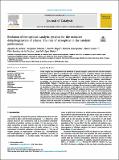Por favor, use este identificador para citar o enlazar a este item:
http://hdl.handle.net/10261/286678COMPARTIR / EXPORTAR:
 SHARE SHARE
 CORE
BASE CORE
BASE
|
|
| Visualizar otros formatos: MARC | Dublin Core | RDF | ORE | MODS | METS | DIDL | DATACITE | |

| Título: | Evolution of the optimal catalytic systems for the oxidative dehydrogenation of ethane: The role of adsorption in the catalytic performance |
Autor: | de Arriba, Agustín CSIC ORCID; Solsona Espriú, Benjamín; Dejoz, Ana M.; Concepción, Patricia CSIC ORCID; Homs, Narcís; Ramírez de la Piscina, Pilar; López Nieto, José Manuel CSIC ORCID | Fecha de publicación: | abr-2022 | Editor: | Elsevier BV | Citación: | Journal of Catalysis 408: 388-400 (2022) | Resumen: | Three samples that correspond to the evolution of optimal catalytic systems for the oxidative dehydrogenation of ethane have been synthesized and compared in terms of catalytic behavior and adsorption properties: (i) vanadium oxide supported on alumina, (ii) Sn-promoted NiO, and (iii) multicomponent MoVTeNbO with the M1 structure. The main difference in catalytic performance lies in the extent of the overoxidation of the ethylene formed, following the order VOx/AlO > NiSnOx > MoVTeNb-M1. Accordingly, the selectivity to ethylene at medium and high ethane conversion follows the order MoVTeNb-M1 > NiSnOx > VOx/AlO These results are confirmed by the relative reaction rates observed for the oxidation of ethane and the oxidation of ethylene. Microcalorimetry studies indicate that the heat of adsorption of both ethane and ethylene is the highest in the most selective MoVTeNb-M1 sample. Thus, the low olefin decomposition in the MoVTeNb-M1 catalyst is not due to weaker adsorption of ethylene but to the reduced ability of its active sites to activate ethylene. The same conclusion regarding the MoVTeNb-M1 catalyst can be drawn by FT-IR of adsorbed ethylene. On the other hand, NiSnOx active sites present a high overoxidation ability, as demonstrated by the notorious formation of oxygenated species, precursors of CO. However, the ethylene decomposition is rather mild because of the existence of many free Lewis sites not involved in the overoxidation reaction. In contrast, in the case of the VO/AlO catalyst, almost all active sites are involved in the oxidation path, so that the olefins decompose readily. | Versión del editor: | http://dx.doi.org/10.1016/j.jcat.2021.07.015 | URI: | http://hdl.handle.net/10261/286678 | DOI: | 10.1016/j.jcat.2021.07.015 | Identificadores: | doi: 10.1016/j.jcat.2021.07.015 issn: 1090-2694 |
| Aparece en las colecciones: | (ITQ) Artículos |
Ficheros en este ítem:
| Fichero | Descripción | Tamaño | Formato | |
|---|---|---|---|---|
| Evolution_of_the_optimal.pdf | 1,75 MB | Adobe PDF |  Visualizar/Abrir |
CORE Recommender
SCOPUSTM
Citations
12
checked on 25-abr-2024
WEB OF SCIENCETM
Citations
12
checked on 21-feb-2024
Page view(s)
14
checked on 05-may-2024
Download(s)
58
checked on 05-may-2024
Google ScholarTM
Check
Altmetric
Altmetric
Este item está licenciado bajo una Licencia Creative Commons

